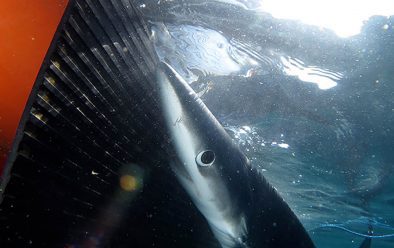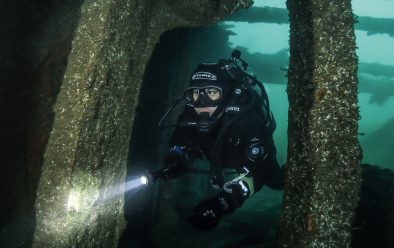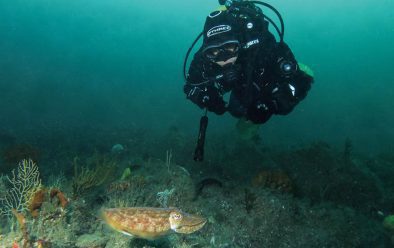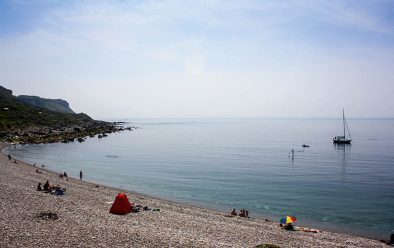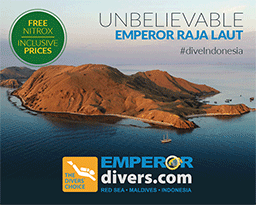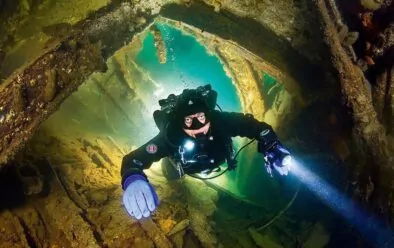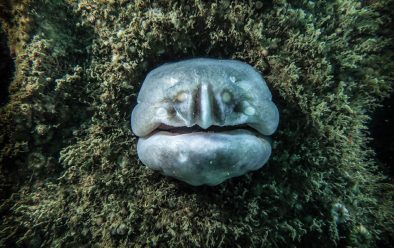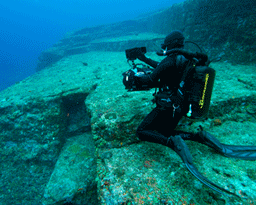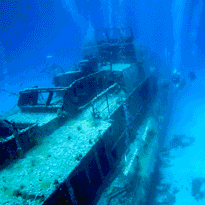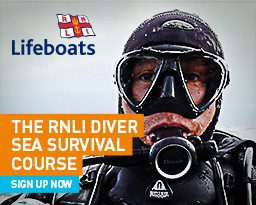
UK DIVER
Tempted by
Temperate Seas
Locked down in Spain, WILL APPLEYARD shared dreams of UK diving through social media. So where will your first post-pandemic dive be?

An afternoon shore-dive, complete with rainbow. Inset: Will Appleyard
Locked down for more than two months in Spain, my interest in fabulous photographs of faraway lands and oceans waned. Temporarily I closed my Instagram app and, besides, at that time those destinations were off-limits anyway.
Rather than scroll, I began to live in the present and be thankful for my health and exercise, keen to remain fit for whatever adventure might await on that far-off horizon.
As spring became more established in southern Spain, my thoughts wandered toward what summertime might offer me in the UK. I began to daydream about exploring some quiet Cornish shore-dive or other, jumping on a boat destined for a site along the Jurassic coast, and mused over exploring a wreck or two.
Digitally, across various social platforms I began to connect more often with folks that I hadn’t spoken to in a while – I guess we all did more of that.
I caught up with many champions of our wild and temperate seas, keen to discover more about what drew them into the underwater world around the UK coastline. For some DIVER readers, the idea of diving anywhere even remotely close to the UK will give rise to those “what do you see down there?” questions or simply “Brrr!”.
For me, however, thinking of these temperate seas generates thoughts of a nutrient-rich ecosystem, remote island exploration, exciting wartime wrecks, colourful jewel-anemone-splattered reefs, easy beach-diving, diver-enveloping shoals of fish, piles of spider crabs, seals, blue sharks and big barrel jellyfish.
I could yarn for pages about my favourite temperate sea-diving experiences and I will allude to a few here, but I have back-up in the form of a selection of UK diving enthusiasts, plucked from my social-media contacts list in a bid to convince non-believers to explore what we have at home.
Sharon Odam, whose club is Diving Dreams, contacted me to share some diving career-defining moments from a day spent off north Devon at Lundy Island, where the Bristol Channel meets the cool clear water of the Atlantic.
“We set out [for the island] on a drizzly Bank Holiday Monday morning,” she began. “The skipper assured us that the weather would clear.
‘We were sceptical, but by the time we were halfway there the sky was clearing. Then we spotted them, a pod of dolphins coming to join us. They played in the wake of the boat for about 10 minutes before getting bored with us. Amazing.
“We moored up next at the mv Robert [a popular Lundy wreck]. As we went down the shotline the wreck came into view. The visibility was about the best I have ever seen in the UK – a totally amazing dive. What a fantastic wreck!
“We then went on to Lundy Island and, after a spot of lunch, the seals that had all been sitting up on the rocks watching us started slipping into the water, so we thought we’d better go and join them.
“We spent the next hour playing with them. They’re the most inquisitive creatures and so much fun. I still have the teeth-marks in my fin to prove it.”
On the southern side of Devon, Plymouth-based diver Liz Yates nominated one of our most famous WW2 relics, the US Liberty ship James Eagan Layne just off Whitsand Bay: “My dad first dived it in 1985,” she explained, “and in his logbook he used one word to describe it: ‘Beautiful’.
“I was lucky enough to have good sea conditions and brilliant visibility on my first dive on the JEL, a bit more weathered and battered by the time I dived it but still beautiful, with wreckage to explore and plenty of sea life.”
I’ve been there myself in recent years and enjoyed some of the finest visibility I’ve ever experienced on a UK wreck-dive.
The wide-open holds are easily penetrable for any experience level and fish are widespread on the wreck. Lying just below 20m on the seabed and beginning a few metres below the surface, it’s a go-to for a first-time UK wreck diver and merits many more visits after that.
“My dad drew me in with his stories of diving in local waters and around the world,” says Liz. “I try to dive all year round, and won’t let a little cold stop me, especially now that I have a heated vest.”
She took up the sport in 2016, mostly with her club and dive-boat charter In Deep. The coasts of Devon and Cornwall will always be exciting to dive, but there’s plenty more to see elsewhere in the UK.
Also inspired by his dad’s diving stories was my Wales-based buddy Lloyd Jones, always good for fascinating online underwater wildlife film footage.
“My father is a diving instructor and as a child I was always fascinated by his local club’s old films from the Red Sea. I loved joining them on trips to west Wales, socialising and listening to members’ stories of marine life and misadventures.
“I’ve always had a passion for videography so my father decided to introduce me to the underwater world and its marine life. With the help of fellow underwater videographers JD Scuba and Ollie Putnam Cinematography we’re hoping to create a series of short videos highlighting the Welsh coastline later this year, titled Wales: Best of The West.”
What sort of critters could I expect to find if I joined Lloyd for a dive in Wales? “Curled octopus. One once darted between me and my father and knocked the mask off my face, inked me and raced off into the blue.
“My father didn’t stop laughing all the way to the surface, and neither did I.”
Unexpected underwater scenarios run in the family, with Lloyd’s partner and diver-buddy Angharad Rees chipping in with another tale:
“One of my favourite dives was Martin’s Haven in west Wales on New Year’s Day; one of my first few dives in the UK. Being brave, wearing a semi-dry (in 4°C water, may I add) my buddy and
I decided to just dive around the bay in the shallows. Thinking I’d been kicking my buddy throughout the dive, I turned to find a seal pup playing with my fins.
“The little chap had been following us the whole dive and playing with our equipment. A moment to warm any heart!”
Martin’s Haven is part of the Skomer nature reserve, and I plan to join Lloyd and Angharad on a dive there as soon as the world is well again.
I love introducing warmwater divers to my favourite UK dive-spots when conditions are at their best. One such introduction was with my partner Ana, now locked down with me so on hand to provide input.
Her only previous diving experience had been in Malaysia.
“My first experience in UK territory was a drift-dive at Old Harry Rocks, where we saw a smooth-hound and a large ray – very exciting as a first experience,” she said. “However, the challenge was to get used to all the extra gear that I was wearing compared with warmwater diving. I felt like an astronaut!”
Smooth-hounds, members of the shark family, are often over 1m long. They love the fast-flowing water at Old Harry Rocks and are regularly seen there by divers, but are still a startling sight on a UK dive.
Gaining more experience, Ana found the right equipment to become comfortable diving in temperate seas and has since enjoyed more than 100 dives around the UK. She has gone on to take that equipment to dive in colder climates too, on the fringes of the Arctic Circle.
Further west from Old Harry Rocks, Chesil Cove on the west side of the Isle of Portland provides just one richly diverse corner in which to discover stacks of interesting species. Regular diver there Colin Garrett messaged me about some of his highlights.
“I must have done maybe 150-plus dives at Chesil Cove and along the beach,” he told me. “I simply love this place as a shore-dive. I’ve seen such a variety of amazing creatures, from the yearly arrival of John Dorys, 4-5ft-long anglerfish, cat sharks, smooth-hounds, rays of all variety, triggerfish [grey triggerfish cross the Atlantic to reach the UK each August], curled octopus, cuttlefish… the list just goes on and on.”
Colin has created a YouTube channel to share his sightings, a facility that kept me entertained during that long period indoors. The cat shark he mentions (aka the dogfish) is a lazy little creature, with beautiful spotty markings and big eyes, found on seabeds all around the UK and easy to approach.
There are several types of ray, which lie camouflaged on the sand, among rocks and beside the reef and can be easy to spot. And one of my most memorable underwater experiences happened from a RIB 16 nautical miles off Penzance with a group of friends one warm June morning.
With no land in sight and a flat sea we spent nearly two hours in the water snorkelling with five slender blue sharks we had encouraged to the boat using chum. A nibble from one of these epipelagic creatures is unlikely but we had covered our flesh with neoprene to deter any such investigation.
The skipper directed us to “keep our eyes on the creatures at all times” while in the water, but in reality they were the ones keeping an eye on us. Horizontal on the surface with perhaps 100m of water below me, I tracked two sharks as they moved stealthily together before swimming out of sight into the gloom. Then the pair would reappear exactly where I didn’t expect them to be. This is their territory.
I met Debra Lilley on a liveaboard in the Red Sea many years ago and swapped details with all the guests on the trip, as one does.
She popped onto my screen to tell me why she enjoys diving her local coastline in Northern Ireland: “My favourite dive-site is Rathlin, a small island of just 6sq miles and a population of about 140.
“The North Wall, about 20-200m, is the most beautiful site. The colours from the sponges, squirts and anemones are a blanket of perfection. We’re blessed with nudibranchs and several species of crab and, look carefully, you will spot lobsters and an amazing kelp forest.”
Diving is not the only reason to visit, says Debra. “Another reason for loving Rathlin is the surface interval between dives. Rathlin is populated, and has a lovely pub where we can go for lunch. How many pubs do you know where turning up in wet dive-gear is the norm? Its Irish stew and wheaten bread
is excellent.”
Debra signed off by saying that: “I do most of my diving here through Seasearch – citizen science at its best. It organises dives with local shops and we record what we observe.”
Appeared in DIVER July 2020
Heading way up north, accomplished underwater photographer and friend Jason Brown pinged me a note to tell me about his favourite places to dive among the scuttled WW1 German fleet at Scapa Flow, in the Orkney Islands.
Jason, dripping with diving qualifications, told me: “For any photographer with a lust for rust, Scapa Flow is hard to beat – where else in the UK can you dive the remains of once-mighty WW1-era battleships bristling with weapons of war?
“While the battleships draw all the attention, I prefer the smaller cruisers. They might lack the big guns of the capital ships but they make for far better dives and – dare I say it – better photographic subjects. They landed on the seabed the right way up, so a lot more of their superstructure is on show.
“The battleships ‘turned turtle’ and rolled over when they sank, hiding most of the interesting stuff. The cruisers also benefit from having sunk in shallower water, which means nice long dives even without the benefit of nitrox!
“If I had to pin down which single Scapa wreck is my favourite, it would be the SMS Coln. It lies in just 22m at its shallowest point and is still surprisingly intact. What makes it special are its cavernous swim-throughs – there’s nothing quite as thrilling as swimming through the lower decks of a WW1-era warship!”
I met Ali Worsley while camped on the beach at Porthkerris in Cornwall a couple of summers ago. Her enviable lockdown location was in the French Alps and we conversed online about her time diving at St Abbs on the UK’s east coast, near the Scottish border. I’m ashamed to say that I still haven’t been diving there, but Ali has convinced me to go this summer.
“Diving in St Abbs should be compulsory,” she says. “It might be far north if you’re a southerner but it’s well worth the trip. If you stay in the village it’s easy diving, a five-minute stroll at most to the harbour wall for loading.
“Many of the dive-sites are a stone’s throw away, so if it’s choppy you can easily bear it – plus the sites tuck into inlets, so there is shelter. Despite being close they’re quite varied; walls, huge granite boulders, knife-edge rock lines to follow and sandy beds.
“The marine life is awesome – lots of squidgy stuff, and a good amount and variety of fish. Lobsters, squat lobsters and crabs are in abundance – you could almost get bored of them!
“The real highlight if you’re lucky is to spot a wolf-fish. Drop below 20m, nose into every nook and cranny and you could be in for a treat!”
Diving at St Abbs really is a rite of passage for UK divers, which is why it has been bumped up my list.
Further south-east, my friend Alex Gibson told me about one of his first UK diving trips to the Farne Islands with Billy Shiel’s Boat Trips from Seahouses.
“I remember it well; it was my first underwater encounter with seals,” he said. “Although that was brief it was truly exciting seeing large, fast, agile animals in our own waters. I immediately wanted more.
“I also remember being pleasantly surprised by the amount of colour all over the rocks – yellow, pink, orange, green, purple and more. A lot of that algal, spongiform, bryozoan and seaweed growth is easy to dismiss because it doesn’t stand too high or form interesting structures (as coral does), but without it there would be a lot of grey and in the right light I think it’s beautiful.”
So social media finally seemed to hold some real significance for me during this time of confinement.
Besides its normal function of showing off our enviably adventurous moments and our best photographic work, at this point I think it was able to bring divers together in a positive way.
And, although we can’t wait to start travelling to the ends of the Earth once again in search of that road less travelled, remote places and pristine seas, perhaps consider that real adventure is often hiding in plain sight, and closer to home than we might think.
Find them on Instagram or YouTube:
Liz Yates @elizab3thyates
Lloyd Jones @krakenproductionstv YT – Kraken Productions TV
Colin Garrett YT – Colin Garrett
Jason Brown @bardophotographic
Alex Gibson @diveduppubs
Will Appleyard @willappleyard
DIVER @diver_magazine
After selling the joys of UK diving to any doubters out there – now, with UK diving the only practical possibility for many of us, WILL APPLEYARD gets practical – click here to see how.
The post Tempted by Temperate Seas appeared first on Divernet.
Read More Features, UK Diving Divernet

